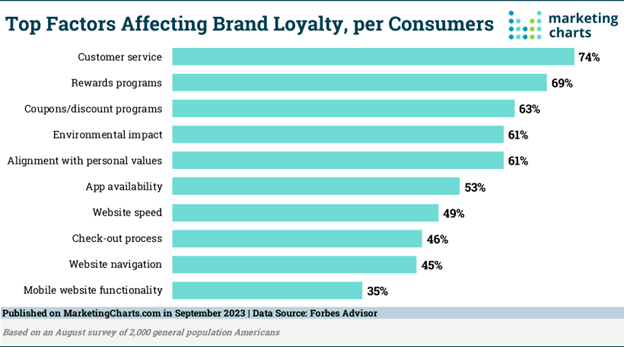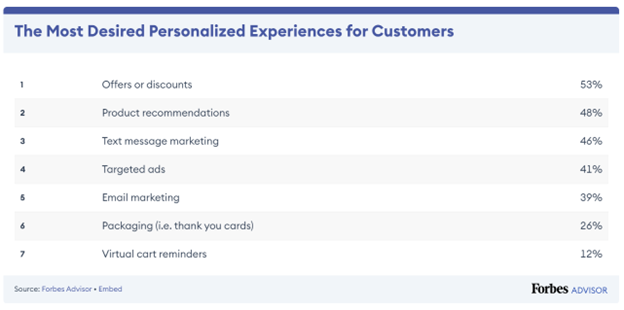While acquiring new customers remains vital for growth, retaining and nurturing existing ones is equally—if not more—important.
In this era of fierce competition, where consumers have more choices than ever, brands must go the extra mile to cultivate the loyalty of their customer base.
So what impacts a consumer’s loyalty? According to research by Forbes Advisor, the top three impacts are:
- 74% – Customer Service
- 69% – Rewards Programs
- 63% – Coupons/Discount Programs
Additionally, 48% of consumers are willing to pay more for quality customer service.

Services Brands Should Offer to Foster Brand Loyalty
The research revealed the services consumers are seeking, including:
- Shipping tracking: When shopping online, 52% of consumers expect to receive regular updates about the status and location of their orders.
- Shopping via social media: As social media platforms evolve into virtual shopping destinations, 41% of consumers seek a seamless shopping experience on social media where they can make a purchase.
- Contactless payments: Tap-to-pay systems and mobile payment solutions are appreciated by 37% of consumers.
- Buy now, pay later options: The option to buy now and pay later can be the deciding factor when deciding to make a purchase for 36% of consumers.
How to Leverage Personalization to Drive Brand Loyalty
Aligning with what we know, that consumers seek personalized experiences, the research also shows that 46% of customers will buy more when given a personalized experience.
The most desired personalized experiences according to consumers include:
- 53% – Offers or discounts
- 48% – Product recommendations
- 46% – Text message marketing
- 41% – Targeted ads
The good news is that consumers are willing to share their information to receive this level of personalization, with 50% of consumers saying they are willing to share personal information (1st party data) for a more personalized experience.

The Role of Marketing Data in Offering Personalization
The ability to offer personalized discounts, product recommendations, and content that aligns with individual preferences lies in marketing data and insights.
Marketing data may include data about customer behavior, demographics, preferences, and interactions with your brand. It can encompass 1st, 2nd, 3rd, and zero-party data. It can be collected from both internal and external sources. But at its core, it serves as the foundation for any personalization strategy.
All Party Data – The Data Parties Explained
First-Party Data
First-party data is information collected directly from your own customers. It is your proprietary data and includes data from interactions, transactions, and engagements that occur on your platforms.
Second-Party Data
Second-party data is obtained through an indirect customer relationship (compared to first-party data, which is a direct customer relationship). This type of data is information the brand didn’t collect but is often obtained by working with a trusted partner who shares audience insights in a mutually beneficial relationship. It may include activity on websites, apps, and social media, survey responses, and more.
Third-Party Data
Third-party data is collected by external sources unrelated to your organization. It is aggregated data that is purchased or acquired from data providers or data aggregators. Third-party data is collected from various sources, such as public records, surveys, or online behavior tracking.
Zero-Party Data
Similar to first-party data, zero-party data is obtained from a direct relationship with the customer and is collected with consent. Examples of zero-party data include communication preferences, product preferences, and customized account configurations.
Tips for Using Marketing Data to Provide Personalization
- Analyze customer purchase history and browsing behavior to suggest products that align with their interests.
- Segment your database using any number of segmentation criteria such as demographics, psychographics, lifestyle and interests, purchase history, or engagement level.
- Send birthday emails or anniversary emails with personalized discounts and coupons.
- Set up behavioral triggers that respond to user actions. For instance, if a customer abandons their shopping cart, send a personalized follow-up email with a discount or reminder.
- Utilize location data to offer location-specific promotions or recommendations.
- Utilize the data collected from social media platforms to target users with personalized ads.
- Use customer data to personalize loyalty programs. Offer rewards and discounts that align with a customer’s past purchases.
Customer loyalty goes far beyond merely attracting new customers. It’s about fostering enduring relationships that lead to growth and profitability. Loyal customers not only make repeat purchases but also become advocates for your brand, spreading positive word-of-mouth and attracting new business to help drive long-term success.





